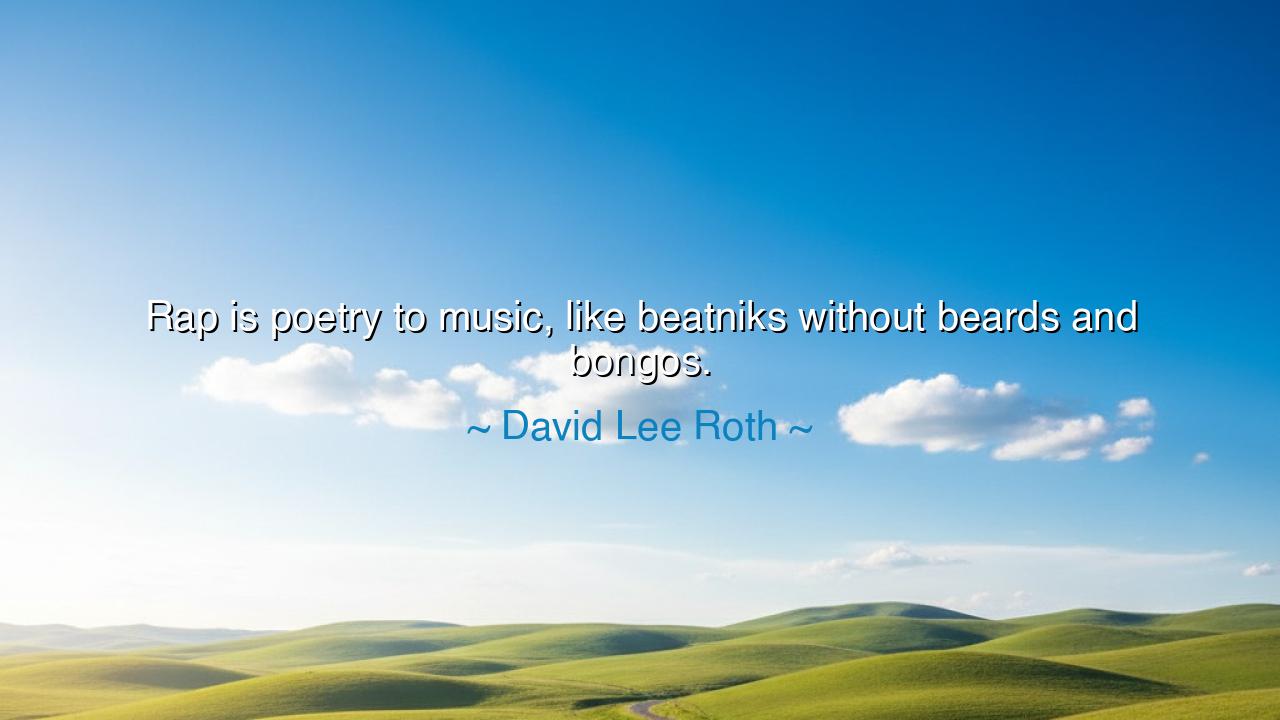
Rap is poetry to music, like beatniks without beards and bongos.






“Rap is poetry to music, like beatniks without beards and bongos.” Thus declared David Lee Roth, a voice of rock and rebellion, who saw in rap not a departure from tradition but a continuation of a lineage of rhythm, word, and performance. His words remind us that art evolves by transforming its garments, yet its essence remains the same. Poetry that once was whispered in cafés, carried by smoke and bongos, has now been reborn in the streets, carried by beats and microphones.
The meaning of this saying lies in the recognition that rap is not separate from the ancient tradition of verse—it is another manifestation of it. Where the beatniks of the 1950s used free verse to challenge conformity and awaken thought, rap emerged from urban struggle, channeling rhythm and rhyme to give voice to the voiceless. Both are children of poetry, both use the spoken word as weapon and sanctuary. Roth’s humor about “without beards and bongos” is his way of showing that the costume has changed, but the spirit of performance poetry remains the same.
The origin of rap itself confirms this truth. Born in the Bronx in the 1970s, it grew from DJs mixing beats and MCs layering rhymes over the sound. Yet these rhymes were not idle chatter—they were verses of protest, joy, storytelling, and defiance. In this, rap resembled the oral traditions of Africa, the griots who carried history through rhythm, or the spoken word of the Harlem Renaissance, where poets like Langston Hughes infused their lines with jazz. Roth’s observation situates rap within this larger continuum of poetic expression.
Consider the story of the Beat Generation. Poets like Allen Ginsberg and Jack Kerouac rejected the polished, academic verse of their time. They sought immediacy, rhythm, and raw honesty—performed aloud, often with the pulse of jazz beneath their words. This was poetry meant to be lived, heard, and felt. Decades later, rap would take the same path, using beats instead of bongos, neighborhoods instead of cafés, but with the same urgency: to speak truth, to stir hearts, to disrupt complacency.
The lesson here is that poetry wears many faces, but its heartbeat is always the same: rhythm, voice, and vision. Do not dismiss new forms of expression simply because they do not resemble the old. What looks strange or radical today may be tomorrow’s canon. Just as the world once doubted the Beat poets, and once dismissed jazz, so rap too was scorned in its infancy. Yet it endures because it is, at its core, poetry—living, breathing, and evolving.
Practically, this means we must listen with open ears and open hearts. If you love poetry, do not confine yourself to dusty pages—listen to the beats of the street, the verses of rap, the performances of slam poetry. There you will hear the same passion, the same craftsmanship, the same hunger for truth. And if you create, know that you do not need beards or bongos, nor microphones or beats; what matters is the rhythm of your words and the honesty of your voice.
Thus the teaching endures: rap is indeed poetry to music, the modern sibling of the beatniks, the latest echo of humanity’s eternal desire to chant, to sing, to declare. David Lee Roth reminds us that while styles shift and symbols change, the essence of poetry remains indestructible. Let us then celebrate rap as part of the great lineage of the spoken word, a fire passed down from age to age, always finding new tongues, always burning with the truth of human expression.






Ddothiphuongvy350
David Lee Roth’s comparison of rap to beatnik poetry is thought-provoking. But I wonder—does this analogy imply that rap is a purely verbal form of expression, leaving out the complexity of the beats and rhythms that make rap unique? Could it be that rap’s true artistry comes not only from the lyrics but from the music itself, and that both elements combine to form something more than poetry in a traditional sense?
SGSu Gia
Roth’s analogy is interesting, but I’m curious—what does he mean by 'beatniks without beards and bongos'? Is he highlighting how rap carries a rebellious spirit without the traditional elements of the beatnik culture, or is he suggesting that rap has become a more accessible, modern version of poetry? How does this analogy shape the way we view rap, both as a genre and as an art form?
CLchim Lon
I like David Lee Roth’s description of rap, but I wonder: does reducing rap to 'poetry to music' oversimplify it? Rap has such a diverse range of styles and voices—can it truly be classified in such a narrow way? While beatniks were rebellious in their own right, rap has evolved into something with its own unique cultural identity. Can we compare the two without losing the nuances of what makes rap distinct?
THDo Thi Thu Huong
Roth’s take on rap as a form of poetry to music makes me think about how both rap and beatnik poetry were forms of rebellion. But does the comparison between rap and beatniks work on a deeper level? How much of rap culture reflects the countercultural spirit of the beatniks, and how much has it evolved beyond that? Does rap still carry the same defiance, or has it become more mainstream?
KNNguyen Thi Kim Ngan
David Lee Roth’s comparison of rap to poetry to music is intriguing. I like how he simplifies the connection between the two by likening rap to beatnik poetry, but without the classic trappings. Is he saying that rap carries the same cultural weight and artistic intent as poetry, but in a more modern form? Does this mean rap can be just as profound as poetry, even if it doesn’t always fit traditional artistic molds?